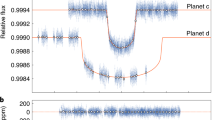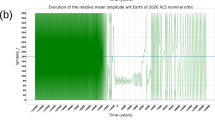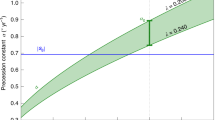Abstract
The discovery of the first interstellar object passing through the Solar System, 1I/2017 U1 (‘Oumuamua), provoked intense and continuing interest from the scientific community and the general public. The faintness of ‘Oumuamua, together with the limited time window within which observations were possible, constrained the information available on its dynamics and physical state. Here we review our knowledge and find that in all cases, the observations are consistent with a purely natural origin for ‘Oumuamua. We discuss how the observed characteristics of ‘Oumuamua are explained by our extensive knowledge of natural minor bodies in our Solar System and our current knowledge of the evolution of planetary systems. We highlight several areas requiring further investigation.
This is a preview of subscription content, access via your institution
Access options
Access Nature and 54 other Nature Portfolio journals
Get Nature+, our best-value online-access subscription
$29.99 / 30 days
cancel any time
Subscribe to this journal
Receive 12 digital issues and online access to articles
$119.00 per year
only $9.92 per issue
Buy this article
- Purchase on Springer Link
- Instant access to full article PDF
Prices may be subject to local taxes which are calculated during checkout




Similar content being viewed by others
Data availability
The authors declare that the main data supporting the findings of this study are available within the article. Extra data are available from the corresponding author upon request.
References
Meech, K. J. et al. A brief visit from a red and extremely elongated interstellar asteroid. Nature 552, 378–381 (2017).
Jewitt, D. et al. Interstellar interloper 1I/2017 U1: observations from the NOT and WIYN telescopes. Astrophys. J. 850, L36 (2017).
Trilling, D. E. et al. Spitzer observations of interstellar object 1I/‘Oumuamua. Astron. J. 156, 261 (2018).
Ye, Q.-Z., Zhang, Q., Kelley, M. S. P. & Brown, P. G. 1I/2017 U1 (‘Oumuamua) is hot: imaging, spectroscopy, and search of meteor activity. Astrophys. J. Lett. 851, L5 (2017).
Bannister, M. T. et al. Col-OSSOS: colors of the interstellar planetesimal 1I/‘Oumuamua. Astrophys. J. 851, L38 (2017).
Fitzsimmons, A. et al. Spectroscopy and thermal modelling of the first interstellar object 1I/2017 U1 ‘Oumuamua. Nat. Astron. 2, 133–137 (2018).
Bolin, B. T. et al. APO time-resolved color photometry of highly elongated interstellar object 1I/‘Oumuamua. Astrophys. J. Lett. 852, L2 (2018).
Moretti, P. F., Maras, A. & Folco, L. Space weathering, reddening and gardening of asteroids: a complex problem. Adv. Space Res. 40, 258–261 (2007).
Fraser, W. C. et al. The tumbling rotational state of 1I/‘Oumuamua. Nat. Astron. 2, 383–386 (2018).
Knight, M. M. et al. On the rotation period and shape of the hyperbolic asteroid 1I/‘Oumuamua (2017 U1) from its lightcurve. Astrophys. J. Lett. 851, L31 (2017).
Warner, B. D., Harris, A. W. & Pravec, P. The asteroid lightcurve database. Icarus 202, 134–146 (2009).
Fujiwara, A. et al. The rubble-pile asteroid Itokawa as observed by Hayabusa. Science 312, 1330–1334 (2006).
Lacerda, P. & Jewitt, D. C. Densities of Solar System objects from their rotational light curves. Astron. J. 133, 1393 (2007).
Zappala, V., Cellino, A., Barucci, A. M., Fulchignoni, M. & Lupishko, D. F. An analysis of the amplitude–phase relationship among asteroids. Astron. Astrophys. 231, 548–560 (1990).
McNeill, A., Trilling, D. E. & Mommert, M. Constraints on the density and internal strength of 1I/‘Oumuamua. Astrophys. J. Lett. 857, L1 (2018).
Drahus, M. et al. Tumbling motion of 1I/‘Oumuamua and its implications for the body’s distant past. Nat. Astron. 2, 407–412 (2018).
Belton, M. J. S. et al. The excited spin state of 1I/2017 U1 ‘Oumuamua. Astrophys. J. Lett. 856, L21 (2018).
Micheli, M. et al. Non-gravitational acceleration in the trajectory of 1I/2017 U1 (‘Oumuamua). Nature 559, 223–226 (2018).
Park, R. S., Pisano, D. J., Lazio, T. J. W., Chodas, P. W. & Naidu, S. P. Search for OH 18 cm radio emission from 1I/2017 U1 with the Green Bank Telescope. Astron. J. 155, 185 (2018).
McGlynn, T. A. & Chapman, R. D. On the nondetection of extrasolar comets. Astrophys. J. Lett. 346, L105–L108 (1989).
Engelhardt, T. et al. An observational upper limit on the interstellar number density of asteroids and comets. Astron. J. 153, 133 (2017).
Meech, K. J. et al. Inner solar system material discovered in the Oort cloud. Sci. Adv. 2, e1600038 (2016).
Jewitt, D. Project Pan-STARRS and the outer Solar System. Earth Moon Planets 92, 465–476 (2003).
Haisch, J., Karl, E., Lada, E. A. & Lada, C. J. Disk frequencies and lifetimes in young clusters. Astrophys. J. 553, L153–L156 (2001).
Pfalzner, S., Steinhausen, M. & Menten, K. Short dissipation times of proto-planetary disks: an artifact of selection effects? Astrophys. J. 793, L34 (2014).
Montesinos, B. et al. Incidence of debris discs around FGK stars in the solar neighbourhood. Astron. Astrophys. 593, A51 (2016).
Wyatt, M. C. Evolution of debris disks. Annu. Rev. Astron. Astrophys. 46, 339–383 (2008).
Raymond, S. N., Armitage, P. J., Veras, D., Quintana, E. V. & Barclay, T. Implications of the interstellar object 1I/‘Oumuamua for planetary dynamics and planetesimal formation. Mon. Not. R. Astron. Soc. 476, 3031–3038 (2018).
Raymond, S. N., Armitage, P. J. & Veras, D. Interstellar object ‘Oumuamua as an extinct fragment of an ejected cometary planetesimal. Astrophys. J. Lett. 856, L7 (2018).
Charnoz, S. & Morbidelli, A. Coupling dynamical and collisional evolution of small bodies: an application to the early ejection of planetesimals from the Jupiter–Saturn region. Icarus 166, 141–156 (2003).
Tremaine, S. in Planets Around Pulsars Vol. 36 (eds Phillips, J. A. et al.) 335–344 (Astronomical Society of the Pacific, 1993).
Raymond, S. N., Armitage, P. J. & Gorelick, N. Planet–planet scattering in planetesimal disks. II. Predictions for outer extrasolar planetary systems. Astrophys. J. 711, 772–795 (2010).
Holman, M. J. & Wiegert, P. A. Long-term stability of planets in binary systems. Astron. J. 117, 621–628 (1999).
Jackson, A. P., Tamayo, D., Hammond, N., Ali-Dib, M. & Rein, H. Ejection of rocky and icy material from binary star systems: implications for the origin and composition of 1I/‘Oumuamua. Mon. Not. R. Astron. Soc. 478, L49–L53 (2018).
Vincke, K. & Pfalzner, S. Cluster dynamics largely shapes protoplanetary disk sizes. Astrophys. J. 828, 48 (2016).
Hands, T. O., Dehnen, W., Gration, A., Stadel, J. & Moore, B. The fate of planetesimal discs in young open clusters: implications for 1I/‘Oumuamua, the Kuiper belt, the Oort cloud and more. Mon. Not. R. Astron. Soc. https://doi.org/10.1093/mnras/stz1069 (2019).
Veras, D. Post-main-sequence planetary system evolution. R. Soc. Open Sci. 3, 150571 (2016).
Trilling, D. E. et al. Implications for planetary system formation from interstellar object 1I/2017 U1 (‘Oumuamua). Astrophys. J. Lett. 850, L38 (2017).
Do, A., Tucker, M. A. & Tonry, J. Interstellar interlopers: number density and origin of ‘Oumuamua-like objects. Astrophys. J. Lett. 855, L10 (2018).
Bialy, S. & Loeb, A. Could solar radiation pressure explain ‘Oumuamua’s peculiar acceleration? Astrophys. J. 868, L1 (2018).
Moro-Martín, A., Turner, E. L. & Loeb, A. Will the Large Synoptic Survey Telescope detect extra-solar planetesimals entering the Solar System? Astrophys. J. 704, 733–742 (2009).
Kroupa, P., Tout, C. A. & Gilmore, G. The distribution of low-mass stars in the Galactic Disc. Mon. Not. R. Astron. Soc. 262, 545–587 (1993).
Cassan, A. et al. One or more bound planets per Milky Way star from microlensing observations. Nature 481, 167–169 (2012).
Mayor, M. et al. The HARPS search for southern extra-solar planets XXXIV. Occurrence, mass distribution and orbital properties of super-Earths and Neptune-mass planets. Preprint at https://arxiv.org/abs/1109.2497 (2011).
Johnson, J. A. et al. A new planet around an M Dwarf: revealing a correlation between exoplanets and stellar mass. Astrophys. J. 670, 833–840 (2007).
Winn, J. N. & Fabrycky, D. C. The occurrence and architecture of exoplanetary systems. Annu. Rev. Astron. Astrophys. 53, 409–447 (2015).
Suzuki, D. et al. The exoplanet mass-ratio function from the MOA-II survey: discovery of a break and likely peak at a Neptune mass. Astrophys. J. 833, 145 (2016).
Zhang, S. et al. The Disk Substructures at High Angular Resolution Project (DSHARP). VII. The planet–disk interactions interpretation. Astrophys. J. Lett. 869, L47 (2018).
Izidoro, A., Morbidelli, A., Raymond, S. N., Hersant, F. & Pierens, A. Accretion of Uranus and Neptune from inward-migrating planetary embryos blocked by Jupiter and Saturn. Astron. Astrophys. 582, A99 (2015).
Moro-Martín, A. Origin of 1I/‘Oumuamua. I. An ejected protoplanetary disk object? Astrophys. J. 866, 131 (2018).
Moro-Martín, A. Origin of 1I/‘Oumuamua. II. An ejected exo-oort cloud object? Astron. J. 157, 86 (2019).
Rafikov, R. R. 1I/2017 ’Oumuamua-like interstellar asteroids as possible messengers from dead stars. Astrophys. J. 861, 35 (2018).
Burgasser, A. J. et al. The Brown Dwarf Kinematics Project (BDKP). IV. Radial velocities of 85 late-M and L dwarfs with MagE. Astrophys. J. Suppl. Ser. 220, 18 (2015).
Anguiano, B., Majewski, S. R., Freeman, K. C., Mitschang, A. W. & Smith, M. C. The velocity ellipsoid in the Galactic Disc using Gaia DR1. Mon. Not. R. Astron. Soc. 474, 854–865 (2018).
Portegies Zwart, S., Torres, S., Pelupessy, I., Bédorf, J. & Cai, M. X. The origin of interstellar asteroidal objects like 1I/2017 U1 ‘Oumuamua. Mon. Not. R. Astron. Soc. 479, L17–L22 (2018).
Almeida-Fernandes, F. & Rocha-Pinto, H. J. A kinematical age for the interstellar object 1I/‘Oumuamua. Mon. Not. R. Astron. Soc. 480, 4903–4911 (2018).
Meech, K. J. & Svoren, J. in Comets II (eds Festou, M. C. et al.) 317–335 (University of Arizona Press, 2004).
Pätzold, M. et al. The nucleus of comet 67P/Churyumov-Gerasimenko — Part I: The global view — nucleus mass, mass loss, porosity and implications. Mon. Not. R. Astron. Soc. 483, 2337–2346 (2019).
Seligman, D., Laughlin, G. & Batygin, K. On the anomalous acceleration of 1I/2017 U1 ‘Oumuamua. Astrophys. J. Lett. 876, L26 (2019).
Fernández, Y. R. et al. Physical properties of the nucleus of comet 2P/Encke. Icarus 147, 145–160 (2000).
Sekanina, Z. Comet Bowell (1980b) — an active-looking dormant object. Astron. J. 87, 161–169 (1982).
Fink, U. Comet Yanaka (1988r) — a new class of carbon-poor comet. Science 257, 1926–1929 (1992).
Schleicher, D. G. The extremely anomalous molecular abundances of comet 96P/Machholz 1 from narrowband photometry. Astron. J. 136, 2204–2213 (2008).
A’Hearn, M. F. et al. Cometary volatiles and the origin of comets. Astrophys. J. 758, 29 (2012).
Ootsubo, T. et al. AKARI near-infrared spectroscopic survey for CO2 in 18 comets. Astrophys. J. 752, 15 (2012).
Biver, N. et al. The extraordinary composition of the blue comet C/2016 R2 (PanSTARRS). Astron. Astrophys. 619, A127 (2018).
Seligman, D. & Laughlin, G. The feasibility and benefits of in situ exploration of ‘Oumuamua-like objects. Astron. J. 155, 217 (2018).
Rickman, H., Kamel, L., Froeschle, C. & Festou, M. C. Nongravitational effects and the aging of periodic comets. Astron. J. 102, 1446–1463 (1991).
Nesvorný, D. et al. Origin and evolution of short-period comets. Astrophys. J. 845, 27 (2017).
Micheli, M., Tholen, D. J. & Elliott, G. T. Detection of radiation pressure acting on 2009 BD. N. Astron. 17, 446–452 (2012).
Sekanina, Z. & Kracht, R. Preperihelion outbursts and disintegration of comet C/2017 S3 (Pan-STARRS). Preprint at https://arxiv.org/abs/1812.07054 (2018).
Moro-Martín, A. Could 1I/‘Oumuamua be an icy fractal aggregate? Astrophys. J. Lett. 872, L32 (2019).
Loeb, A. Six strange facts about ‘Oumuamua. Preprint at https://arxiv.org/abs/1811.08832 (2018).
Siraj, A. & Loeb, A. ‘Oumuamua’s geometry could be more extreme than previously inferred. Res. Notes Am. Astron. Soc. 3, 15 (2019).
Thomas, C. A. et al. ExploreNEOs. V. Average albedo by taxonomic complex in the near-Earth asteroid population. Astron. J. 142, 85 (2011).
Kokotanekova, R. et al. Rotation of cometary nuclei: new light curves and an update of the ensemble properties of Jupiter-family comets. Mon. Not. R. Astron. Soc. 471, 2974–3007 (2017).
Katz, J. I. Why is interstellar object 1I/2017 U1 (‘Oumuamua) rocky, tumbling and possibly very prolate? Mon. Not. R. Astron. Soc. 478, L95–L98 (2018).
Ćuk, M. 1I/ ‘Oumuamua as a tidal disruption fragment from a binary star system. Astrophys. J. Lett. 852, L15 (2018).
Domokos, G., Sipos, A. Á., Szabó, G. M. & Várkonyi, P. L. Formation of sharp edges and planar areas of asteroids by polyhedral abrasion. Astrophys. J. Lett. 699, L13–L16 (2009).
Vavilov, D. E. & Medvedev, Y. D. Dust bombardment can explain the extremely elongated shape of 1I/‘Oumuamua and the lack of interstellar objects. Mon. Not. R. Astron. Soc. Lett. 484, L75–L78 (2019).
Sugiura, K., Kobayashi, H. & Inutsuka, S.-i. Collisional elongation: possible origin of extremely elongated shape of 1I/’Oumuamua. Icarus 328, 14–22 (2019).
Stern, S. A. et al. Overview of initial results from the reconnaissance flyby of a Kuiper belt planetesimal: 2014 MU69. Preprint at arXiv https://arxiv.org/abs/1901.02578 (2019).
Pravec, P. et al. Tumbling asteroids. Icarus 173, 108–131 (2005).
Kwiecinski, J. A., Krause, A. L. & Van Gorder, R. A. Effects of tidal torques on 1I/2017 U1 (‘Oumuamua). Icarus 311, 170–174 (2018).
Rafikov, R. R. Spin evolution and cometary interpretation of the interstellar minor object 1I/2017 ‘Oumuamua. Astrophys. J. Lett. 867, L17 (2018).
Bailer-Jones, C. A. L. et al. Plausible home stars of the interstellar object ‘Oumuamua found in Gaia DR2. Astron. J. 156, 205 (2018).
Zuluaga, J. I., Sánchez-Hernández, O., Sucerquia, M. & Ferrín, I. A general method for assessing the origin of interstellar small bodies: the case of 1I/2017 U1 (‘Oumuamua). Astron. J. 155, 236 (2018).
Dybczyński, P. A. & Królikowska, M. Investigating the dynamical history of the interstellar object ‘Oumuamua. Astron. Astrophys. 610, L11 (2018).
Zhang, Q. Prospects for backtracing 1I/‘Oumuamua and future interstellar objects. Astrophys. J. Lett. 852, L13 (2018).
Gaidos, E. What and whence 1I/‘Oumuamua: a contact binary from the debris of a young planetary system? Mon. Not. R. Astron. Soc. 477, 5692–5699 (2018).
Feng, F. & Jones, H. R. A. ‘Oumuamua as a messenger from the local association. Astrophys. J. Lett. 852, L27 (2018).
Cook, N. V., Ragozzine, D., Granvik, M. & Stephens, D. C. Realistic detectability of close interstellar comets. Astrophys. J. 825, 51 (2016).
Simon, J. B., Armitage, P. J., Youdin, A. N. & Li, R. Evidence for universality in the initial planetesimal mass function. Astrophys. J. Lett. 847, L12 (2017).
Schäfer, U., Yang, C.-C. & Johansen, A. Initial mass function of planetesimals formed by the streaming instability. Astron. Astrophys. 597, A69 (2017).
Dohnanyi, J. S. Collisional model of asteroids and their debris. J. Geophys. Res. 74, 2531–2554 (1969).
Pajola, M. et al. Size-frequency distribution of boulders ≥7 m on comet 67P/Churyumov-Gerasimenko. Astron. Astrophys. 583, A37 (2015).
Acknowledgements
We thank the International Space Science Institute (ISSI Bern), which made this collaboration possible. A.F., M.T.B. and C.S. acknowledge support from UK Science and Technology Facilities Council grants ST/P0003094/1 and ST/L004569/1. K.J.M. acknowledges support through NSF awards AST1617015, in addition to support for HST programmes GO/DD-15405 and -15447 provided by NASA through a grant from the Space Telescope Science Institute, which is operated by the Association of Universities for Research in Astronomy under NASA contract NAS 5-26555. Q.Y. is supported by the GROWTH project funded by the National Science Foundation under Grant No. 1545949. This research was partially supported by the project 2015/17/B/ST9/01790 funded by the National Science Centre in Poland. M.M.K. acknowledges support from NASA Near Earth Object Observations grant no. NNX17AK15G. A.G.-L. acknowledges funding from the European Research Council under grant agreement no. 802699. A.M. and D.E.T. are supported in part by Spitzer/NASA through an award issued by JPL/Caltech. S.N.R. acknowledges helpful discussions with P. Armitage related to the interstellar object number/mass density, and the Virtual Planetary Laboratory research team, funded by the NASA Astrobiology Program under NASA Grant Number 80NSSC18K0829. This work benefited from participation in the NASA Nexus for Exoplanet Systems Science research coordination network.
Author information
Authors and Affiliations
Consortia
Contributions
M.M.K. and A.F. organized the ISSI team. K.J.M. created Figs. 1 and 2. S.N.R. conducted the modelling of inferred interstellar object number density and created Fig. 3. M.M.K., A.F. and R.J. created Fig. 4 from source data provided by T. Engelhardt. All authors discussed the topics in the paper, contributed to the writing and commented on the manuscript at all stages.
Corresponding author
Ethics declarations
Competing interests
The authors declare no competing interests.
Additional information
Peer review information: Nature Astronomy thanks Olivier Hainaut and the other, anonymous, reviewer(s) for their contribution to the peer review of this work.
Publisher’s note: Springer Nature remains neutral with regard to jurisdictional claims in published maps and institutional affiliations.
Rights and permissions
About this article
Cite this article
The ‘Oumuamua ISSI Team. The natural history of ‘Oumuamua. Nat Astron 3, 594–602 (2019). https://doi.org/10.1038/s41550-019-0816-x
Received:
Accepted:
Published:
Issue Date:
DOI: https://doi.org/10.1038/s41550-019-0816-x
This article is cited by
-
Recent arrivals to the main asteroid belt
Celestial Mechanics and Dynamical Astronomy (2022)
-
A fast response mission to rendezvous with an interstellar object
Experimental Astronomy (2022)
-
Ariel – a window to the origin of life on early earth?
Experimental Astronomy (2022)
-
The ‘Oumuamua controversy
Nature Astronomy (2021)
-
Compact pebbles and the evolution of volatiles in the interstellar comet 2I/Borisov
Nature Astronomy (2021)



